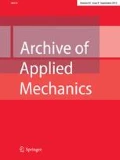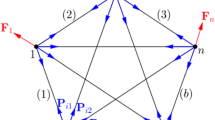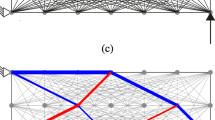Abstract
Force density method together with topological mapping has been employed to perform the form-finding process of tension structures. Compression-only structures such as domes and vaults can be modelled if the former approach is modified. This modification consists of iteratively introducing the self-weight of the structure to be modelled until the equilibrium configuration is found. This method is similar to the hanging chain models employed by Antonio Gaudí when designing his structures. The approach allows rapidly changing the input parameters in order to get different equilibrium configurations.













Similar content being viewed by others
Abbreviations
- A :
-
Adjacency matrix of the mesh. Dimension: \(n_\mathrm{{n}} \times n_\mathrm{{n}}\).
- C :
-
Connectivity matrix. Dimension: \(n_\mathrm{{b}} \times n_\mathrm{{n}} \).
- l :
-
Branch length.
- nit:
-
Number of iteration in the iterative FDM.
- nit\(_{\max } \) :
-
Maximum number of iteration for the iterative FDM.
- \(n_\mathrm{{b}} \) :
-
Number of branches in the mesh.
- \(n_\mathrm{{n}} \) :
-
Number of nodes in the mesh.
- \(n_\mathrm{{nr}} \) :
-
Number of nodes per ring.
- \(n_\mathrm{{r}} \) :
-
Number of rings in the mesh.
- \(\mathbf{P}_x ,\mathbf{P}_y ,\mathbf{P}_z \) :
-
Vectors containing the values of nodal forces in \(x\,y\,z\) directions respectively.
- \(\mathop {\mathbf{P}_z}\limits ^\Delta \) :
-
Vector containing the nodal forces in z direction corresponding to the weight of the mesh.
- \(\mathop {P_{z_i } }\limits ^\Delta \) :
-
Each of the components of vector \(\mathop {\mathbf{P}_z }\limits ^\Delta \) that contains the summation of one-third of the weights of the triangles that contain the node i as a vertex.
- Q :
-
Force density matrix. Diagonal matrix of dimension: \(n_\mathrm{{b}} \times n_\mathrm{{b}} \).
- q :
-
Force density ratio.
- \(\mathbf{q}_{\mathrm{{rad}}}\) :
-
Force density ratio vector for radial branches groups.
- \(\mathbf{q}_\mathrm{{ring}} \) :
-
Force density ratio vector for ring branches groups
- S :
-
Branch force.
- u :
-
Difference vector of coordinates x for the extreme nodes in each branch of the mesh.
- v :
-
Difference vector of coordinates y for the extreme nodes in each branch of the mesh.
- x, y, z :
-
Vectors with the \(x\,y\,z\) coordinates of the nodes in the mesh, respectively.
- \(\mathbf{x}_\mathrm{{f}} ,\mathbf{y}_\mathrm{{f}} ,\mathbf{z}_\mathrm{{f}}\) :
-
Vectors with the \(x\,y\,z\) coordinates of the fixed nodes in the mesh, respectively
- \(\mathbf{x}^\mathrm{{nit}},\mathbf{y}^\mathrm{{nit}},\mathbf{z}^\mathrm{{nit}}\) :
-
Vectors with the \(x\,y\,z\) coordinates of nodes in the mesh computed in iteration nit in the iterative FDM, respectively
- \(\Delta z^\mathrm{{nit}}\) :
-
Difference between the z coordinate of the nodes in the mesh computed in two successive iterations nit and nit\(-\)1.
- \(\Delta z_{\max } \) :
-
Maximum allowable difference between the z coordinate of the nodes in the mesh computed in two successive iterations nit and nit\({-}\)1 (convergence criterion).
- \(\gamma \) :
-
Adopted surface density used in the computation of the mesh’s self-weight.
References
Huerta, S.: Structural design in the work of Gaudí. Archit. Sci. Rev. 49(4), 324–339 (2006)
Gómez-Serrano, J.: Arcos catenarios. In: Giralt-Miracle, D. (ed.) Gaudí, la búsqueda de la forma: espacio, geometría, estructura y construcción, pp. 97–101. Lunwerg, Barcelona (2002)
Kilian, A.: Linking hanging chain models to fabrication. ACADIA 1-17. http://designexplorer.net/newscreens/cadenarytool/KilianACADIA.pdf. Accessed 28 May 2015 (2004)
Bletzinger, K.-U., Wüchner, R., Daoud, R., Daoud, F., Camprubí, N.: Computational methods for form finding and optimization of shells and membranes. Comput. Methods Appl. Mech. Eng. 194(30–33), 3438–3452 (2005)
Barnes, M.R.: Form finding and analysis of tension structures by dynamic relaxation. Int. J. Space Struct. 14(2), 89–104 (1999)
Linkwitz, K., Schek, H.J.: Einige Bemerkung von vorsgepannten Seilnetzkonstruktionen. Ingenieur-archv 40, 145–158 (1971)
Linkwitz, K.: About formfinding of double-curved structure. Eng. Struct. 21, 709–718 (1999)
Schek, H.J.: The force density method for form finding and computation of general networks. Comput. Methods Appl. Mech. Eng. 3, 115–134 (1974)
Greco, L., Cuomo, M.: On the force density method for slack cable nets. Int. J. Solids Struct. 49(13), 1526–1540 (2012)
Koohestani, K.: Form-finding of tensegrity structures via genetic algorithm. Int. J. Solids Struct. 49(5), 739–747 (2012)
Zhang, L.-Y., Zhao, H.-P., Feng, X.-Q.: Constructing large-scale tensegrity structures with bar-bar connection using prismatic elementary cells. Arch. Appl. Mech. 85(3), 383–394 (2014)
Hernández-Montes, E., Jurado-Piña, R., Bayo, E.: Topological mapping for tension structures. J. Struct. Eng. ASCE 132(6), 970–977 (2006)
Carbonell-Márquez J.F., Gil-Martín L.M., Hernández-Montes E., Jurado-Piña R.: GAUDI 1.0–Manual de Usuario. Godel Impresiones Digitales, Granada. (2012) http://www.ugr.es/~tep190/investigacion/gaudi.html. Accessed 30 May 2015
Jurado-Piña, R., Gil-Martín, L.M., Hernández-Montes, E.: Topological mesh for shell structures. Appl. Math. Model. 33(2), 948–958 (2009)
Computers and Structures Inc. (CSI): SAP2000: Integrated software for structural analysis and design. CSI, Berkeley, CA (2009)
Eurocode 2: Design of Concrete Structures-Part 1–1: General Rules and Rules for Buildings. CEN, Belgium (2004)
Acknowledgments
The present work was partially financed by the Spanish Ministry of Education by means of PhD grant to the first author (FPU grant AP 2010-3707). This support is gratefully acknowledged.
Author information
Authors and Affiliations
Corresponding author
Rights and permissions
About this article
Cite this article
Carbonell-Márquez, J.F., Gil-Martín, L.M., Fernández-Ruíz, M.A. et al. Topological design of compression structures. Arch Appl Mech 86, 1495–1508 (2016). https://doi.org/10.1007/s00419-016-1131-y
Received:
Accepted:
Published:
Issue Date:
DOI: https://doi.org/10.1007/s00419-016-1131-y




